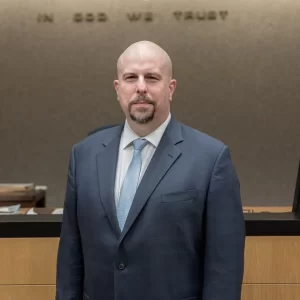Chris Psomopoulos, Esq.
Criminal Lawyer
Chris Psomopoulos started his own practice upon graduating from law school. Mr. Psomopoulos has focused his practice on representing buyers, sellers, developers, investors, and landlords in the purchase, sale and leasing of both commercial and residential real estate properties. In addition, he has vast experience helping homeowners experiencing financial difficulties and facing foreclosure. He prides himself in his understanding and responsiveness to all of his client needs.
Admitted to practice in the State of New York, Mr. Psomopoulos received his Juris Doctor from the Maurice A. Deane School of Law and his Bachelor of Business Administration from Hofstra University.
Jeffrey Chabrowe
Criminal Lawyer
When you are facing criminal charges, you cannot afford anything less than the most effective defense you can secure. Your future is at stake. Often, the only thing standing between a person accused of committing a crime and a conviction is his or her lawyer. Given what is at stake, you owe it to yourself to choose an attorney with skill, experience and a record of results that he or she can point to as proof of his or her abilities.
Attorney Jeffrey Chabrowe spent seven years in the Manhattan District Attorney’s Office before becoming a defense attorney. Those years spent prosecuting cases allowed him to develop all of the skills necessary to serve as a highly effective defense attorney. He has extensive trial experience and a record of success handling the most challenging cases.
Many of those cases were covered in the press. The help Jeffrey Chabrowe has provided to his clients has been highlighted in many press sources, including the New York Times and the New York Post. He has built this record of success through his skill as both a litigator and a negotiator.
Jenn Peters
Criminal Lawyer
Jenn Peters is an Associate Attorney with the Law Offices of Julie Rendelman.
Prior to joining the firm, Jenn worked as a Public Defender in Manhattan, where she handled countless cases, ranging from larcenies and assaults, to DWIs and sex offenses. In her most recent trial, Jenn and her co-counsel were able to get a First-Degree Robbery indictment dismissed in the middle of the trial.
During law school at Chicago-Kent College of Law, Jenn worked as a law clerk for a criminal appeals and post-conviction law firm, where she wrote appellate briefs and post-conviction petitions for various murder cases. In law school, Jenn won Best Oral Advocate at the Domenick L. Gabrielli Appellate Advocacy Competition, and graduated cum laude with five CALI awards.
Jenn received her BA in Legal Studies from the University of Waterloo, where she won the Reginald A. Haney award for the student in the Legal Studies program with the highest academic standing. She then received her Master’s Degree in Criminology and Socio-Legal Studies from the University of Toronto. Jenn went on to conduct ethnographic research on the police harassment and prosecution of outlaw motorcycle clubs in Canada, before ultimately pursuing her dream since childhood to become a criminal defense attorney.
Jenn is originally from Canada, and is fluent in French. True to Canadian form, Jenn was a competitive figure skater for 15 years before becoming an attorney. Her background as a high-level performer has made her fearless in the courtroom, and has instilled in her a competitive edge and desire to win, which she has carried over from the rink to her clients’ cases.
Ed Palermo, Esq.
Criminal Lawyer
I am a Suffolk County Criminal and DWI Lawyer with more than 28 years of experience. I concentrate my practice on helping individuals who face criminal and DWI charges. I have represented more than 1000 Long Island and NYC residents over my career.
I am proud of my track record of success. Helping my clients is my only goal. If you or a loved one needs a Suffolk County Criminal DWI Lawyer, please do not hesitate to call me today. I am always here to help.
There is no substitute for experience when finding a Suffolk County Criminal and DWI Lawyer. I am always happy to extend my family of clients. I will fight for you and make sure that you always feel protected and secure.
I have forged terrific relationships with the judges and prosecutors. These relationships are incredibly important. I value them as an asset when representing my clients. I am a Suffolk County Criminal and DWI Lawyer with the professional relationships and concentrated experience to get the result you need.
My depth of experience for over 28 years as a Suffolk County Criminal and DWI Lawyer has honed my skills. The results I can achieve now are far more beneficial to my clients. Hiring a skilled, thoroughly experienced Suffolk County Criminal and DWI Attorney is the key to achieving a successful outcome in your case.
I will answer all of your questions. I will explain all the criminal or DWI charges you face. I will explain potential strategies to win your case. New clients ALWAYS feel better after they speak to me.
Laurence A. Silverman, Esq.
Criminal Lawyer
Hart graduated from UC Berkeley at the top of his class, where he received his Bachelor of Arts with Honors. He attended Loyola Law School where he also graduated with Honors. Hart Levin began his career working as an associate at a prominent civil law firm in Westwood, CA, McNicholas & McNicholas LLP, where he worked complex civil cases and large class action suits.
Hart went on to become a Deputy District Attorney for Los Angeles where he prosecuted thousands of criminal cases including: DUI, vehicular manslaughter, sex crimes, domestic violence, gang crimes, murder and attempted murder, assaults, weapons violations, narcotic trafficking and sales, fraud, embezzlement, arson, rape, robbery, burglary, organized crimes, crimes against peace officers, and hate crimes. Hart has conducted over seven hundred preliminary hearings, handled thousands of misdemeanor cases, adjudicated matters in juvenile court, and personally has taken numerous felony and misdemeanor matters to jury trial achieving outstanding results.
Additionally, Attorney Silverman handles, murder, robbery, rape, and other sex offenses, individual or gang assault, grand larceny, embezzlement, tax fraud, gun, and other weapons possession, larceny, possession of stolen property, damage to property, and petty theft. Mr. Silverman’s clients speak of him as a compassionate, successful, and effective Suffolk County criminal lawyer.
Elaine M. Colavito, Esq.
Criminal Lawyer
Elaine M. Colavito is a Partner with the firm, primarily handling matrimonial and family Law matters. She also handles immigration and trusts and estates matters. She is admitted to practice in the State of New York and before the U.S. Supreme Court. She graduated summa cum laude from the State University of New York at Stony Brook and magna cum laude from Touro College Jacob D. Fuchsberg Law Center in the top 6% of her class.
Ms. Colavito is active in local bar associations. She is a past president of the Nassau County Women’s Bar Association. She joined the organization in 2012 as a Member of its Board of Directors and has also served as its Treasurer, Vice President, President-Elect, and a delegate to the Women’s Bar Association of the State of New York. At various times, she has also chaired several committees for the bar association including Finance, Membership, Matrimonial and Family Law, Nominations Committee, Installation, and Working Parents. In 2013, she received the group’s Bessie Ray Geffner, Esq. Memorial Award for her demonstrated interest in improving the justice system, professionalism of the bar and service to the community at large and in 2023, she received the group’s Virginia C. Duncombe, Esq. Award, presented annually to foster and enhance ongoing legal education.
Ms. Colavito is presently a Vice President of the Nassau County Women’s Bar Association Foundation, the charitable arm of the Nassau County Women’s Bar Association, previously serving on its Board of Directors, and as a Recording Secretary. Ms. Colavito is a member of the Suffolk Bar Association and is chairperson of the Paraprofessional Committee. At the State Bar level, Ms. Colavito has served as a chairperson of the Family and Matrimonial Committee.
Ms. Colavito wrote a monthly column, entitled Decisions of Interest for the Suffolk Lawyer, a publication of the Suffolk County Bar Association from 2008-2020. She is also the author of an article entitled “Social Networking Sites and the Right to Privacy: Kathleen Romano v. Steelcase and Educational Institutional Cooperative Services, Inc., Index No. 2233/06” that appeared in the Winter 2011 edition of the Medicine and Law Committee Newsletter, a publication of the American Bar Association. She has also lectured before the NYSBA Young Lawyers section. Ms. Colavito is also a lecturer in an ABA certified paralegal studies program at a local law school and has taught classes on the topics of Family Law, Trusts & Estates, Civil Litigation, Legal Research & Writing, and Immigration. She lectures in a Real Estate Broker Qualifying Course.
In 2014, she was named to Super Lawyers’ “Rising Stars” list in the area of Family Law, and was among the 2015-2022, Super Lawyers “Top Women Lawyers in New York.” In 2017, she was named a Trailblazer in Divorce and Trusts and Estates by The National Law Journal and in 2017 and 2018 received the Top 50 Women in Business and Leadership in Law awards from Long Island Business News. In 2018 and 2019, she received the Maurice A. Deane School of Law at Hofstra University’s Outstanding Woman in the Law award. In 2021 and 2022, she received the Long Island Herald’s Premier Businesswomen Award.
Jason Bassett
Criminal Lawyer
Practice Areas:
- Burglary Lawyer
- Federal Criminal Defense
- DWI & DUI Defense
- Homicide Lawyer
- Desk Appearance Ticket Lawyer
- Domestic Violence Lawyer
- Robbery Lawyer
- Sex Crimes Lawyer
- Medical License Defense Attorney
- Assault Defense Attorney
- Juvenile Delinquency Lawyer
- Excessive Force/False Arrest
Marc C. Gann, Esq.
Criminal Lawyer
Marc Gann is one of the most highly regarded criminal defense lawyers on Long Island and has handled countless high-profile cases across the New York metropolitan area. He handles criminal cases of all shapes and sizes, from simple traffic or DUI cases to the most serious major felonies.
Marc possesses particular experience defending murder and drug cases, including serious conspiracy matters in both New York state and federal courts, and has also taken verdicts on major felony cases including burglary, robbery, and fraud.
Marc Gann earns most of his clients via referral from other lawyers, court personnel, or past clients. Martindale-Hubbell also agrees that he is an attorney of the highest level of skill and ethics, having awarded him the AV rating.
Like his fellow partners, Marc Gann was a prosecutor in Nassau County for several years. He then spent several years in Baltimore handling criminal and civil cases before returning to New York to form Collins Gann McCloskey & Barry PLLC.
In addition to defending criminal cases, Marc also counsels sports nutrition companies and has litigated personal injury and other civil cases.
What Is the Difference Between Manslaughter and Murder?
When it comes to serious criminal offenses involving the death of a person, terms like “manslaughter” and “murder” are often used. While both manslaughter and murder involve the unlawful killing of another person, the key difference lies in the circumstances surrounding the crime and the intent of the perpetrator. This distinction is crucial, as it determines the severity of the charges and the resulting penalties.
We will explore the legal definitions, elements, and various degrees of both manslaughter and murder to provide a clearer understanding of the differences between the two.
Definition of Murder
Murder is the more severe of the two offenses and is defined as the unlawful killing of another human being with “malice aforethought.” The concept of malice aforethought means that the perpetrator acted with the intention to kill or cause serious harm, or demonstrated a reckless disregard for human life. Murder is usually classified into two main degrees: first-degree murder and second-degree murder.
1. First-Degree Murder
First-degree murder is the most serious type of homicide. It involves premeditation, meaning the killing was planned or deliberate. The perpetrator must have formed the intent to kill and then acted upon that intent. Premeditation does not necessarily mean that the act was planned for a long time; it can be formed in a very short period before the actual act, but the key element is the purposeful nature of the crime.
Other circumstances that elevate a killing to first-degree murder may include:
- The use of particularly cruel methods, such as torture.
- The killing of a law enforcement officer.
- Felony murder, where a person is killed during the commission of another serious crime, like robbery or kidnapping.
Because first-degree murder is seen as the most intentional and egregious form of homicide, it carries the harshest penalties, including life imprisonment without parole or, in some jurisdictions, the death penalty.
2. Second-Degree Murder
Second-degree murder also involves intentional killing, but without premeditation or deliberation. The act may be spontaneous or occur during a heat-of-the-moment situation. However, second-degree murder still requires malice aforethought, meaning the perpetrator either intended to cause death or serious injury or acted with reckless indifference to human life.
An example of second-degree murder would be a person getting into a heated argument and, in the spur of the moment, fatally striking the other person without any prior intent to kill.
Because second-degree murder lacks the planning and premeditation of first-degree murder, the penalties, though severe, are usually less harsh. Typical sentences range from 15 years to life imprisonment, depending on the circumstances and jurisdiction.
Definition of Manslaughter
Manslaughter, unlike murder, generally refers to a killing that occurs without malice aforethought. The perpetrator did not intend to kill, or if they did, the circumstances surrounding the killing mitigate their culpability. Manslaughter is further divided into two categories: voluntary manslaughter and involuntary manslaughter.
1. Voluntary Manslaughter
Voluntary manslaughter occurs when someone kills another person in the “heat of passion” as a result of being provoked. In such cases, the provocation must be of such intensity that it would cause a reasonable person to lose self-control. The key element here is the lack of prior intent to kill, as the actions are spontaneous and occur in response to a highly emotional situation.
A classic example of voluntary manslaughter would be discovering a spouse in the act of infidelity and, in a fit of rage, immediately killing the other party. In this case, while the intent to kill exists, the emotions of the moment reduce the moral blameworthiness of the crime compared to murder.
The penalties for voluntary manslaughter are generally less severe than for murder but can still involve significant prison time, often ranging from 3 to 15 years, depending on the jurisdiction and specific circumstances of the crime.
2. Involuntary Manslaughter
Involuntary manslaughter, as the name suggests, involves an unintentional killing. This type of manslaughter usually occurs as a result of reckless or negligent behavior that leads to someone’s death. Unlike murder or voluntary manslaughter, there is no intent to kill or cause serious harm, but the perpetrator’s actions are deemed irresponsible enough to result in a criminal charge.
For instance, driving under the influence of alcohol and causing a fatal accident would typically be classified as involuntary manslaughter. The driver did not intend to kill, but their reckless behavior (driving while intoxicated) led to someone’s death.
Penalties for involuntary manslaughter are often the least severe of all homicide-related crimes, though they can still be quite significant, particularly when gross negligence is involved. Sentences can range from probation to several years in prison.
Key Differences Between Manslaughter and Murder
While manslaughter and murder both involve the unlawful killing of another person, the major difference is the element of intent and state of mind of the perpetrator. Murder requires malice aforethought, meaning the killer acted with intent or extreme recklessness, whereas manslaughter involves a lack of intent to kill or a killing under circumstances that reduce the moral culpability.
Here are the key distinctions between the two crimes:
- Intent: Murder involves intent to kill or extreme recklessness, whereas manslaughter often involves no intent to kill or a killing that occurs under emotional duress or negligence.
- Premeditation: First-degree murder requires premeditation, while manslaughter typically occurs without any planning.
- Mitigating Circumstances: Manslaughter cases often involve mitigating factors, such as provocation or reckless behavior, which reduce the moral blameworthiness compared to murder.
- Penalties: The penalties for murder are typically much harsher than for manslaughter. First-degree murder may result in life imprisonment or the death penalty, while manslaughter carries lighter sentences, though they can still involve significant jail time.
Legal and Moral Implications
The distinction between murder and manslaughter is significant in both a legal and moral sense. Murder is generally viewed as the more heinous crime due to the perpetrator’s intent and the level of planning involved. On the other hand, manslaughter, while still a grave offense, is considered less morally reprehensible because it often occurs without premeditation or under emotional distress.
Courts consider various factors when determining the appropriate charge and penalty, including the circumstances of the killing, the intent of the perpetrator, and any mitigating or aggravating factors.
Conclusion
Understanding the difference between manslaughter and murder is essential, especially in legal contexts where the specific charge can drastically affect the outcome of a case. While both offenses involve the unlawful killing of another person, the key difference lies in the intent and circumstances surrounding the crime. Murder involves malice aforethought, either in the form of intent or extreme recklessness, while manslaughter generally involves less culpability due to a lack of intent or emotional provocation. As a result, the legal and moral weight of each crime varies, as do the associated penalties.










